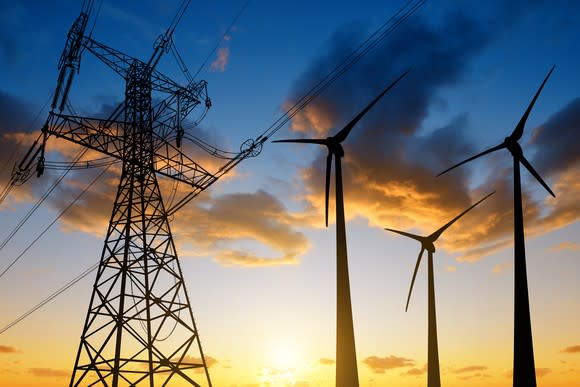This Could Be a Surprising Renewable Energy Catalyst
Fossil fuels aren't going away anytime soon. But in order to meet the electricity needs of a growing global population, renewable energy, more commonly known as "green energy," is being increasingly relied on to fill the gap, so to speak.
According to the International Energy Agency (IEA), renewable energy, which includes solar, wind, hydroelectric, and geothermal power, accounted for almost two-thirds of global net capacity additions in 2016. Whereas 26 gigawatts (GW) of coal-powered generation was retired in 2016 (though 31 GW was added in net), a net of 74 GW of new solar photovoltaic capacity was added, along with 52 GW in net wind power additions. These clean fuel sources, while potentially pricy investments upfront, should pay off over the long run with considerably lower kilowatt per hour (kWH) costs.

Image source: Getty Images.
The IEA continues to see a bright future ahead for green energy, pun aside. Estimates call for 920 GW of global renewable electricity capacity growth by 2022 over 2016. And, assuming government policy in countries like China and India lifts barriers to growth, the IEA believes renewable capacity growth could expand to as much as 1,150 GW.
However, lifting barriers to growth isn't the only catalyst that could cause green-based electricity demand to skyrocket in the years to come. Instead, green-energy investors might want to thank bitcoin, Ethereum, and other mineable cryptocurrencies for fueling the push to renewable sources of energy.
Certain cryptocurrencies, like bitcoin and Ethereum, require a lot of electricity usage
While there are a handful of ways that cryptocurrency transactions are validated on a blockchain network -- blockchain being the digital, distributed, and decentralized ledger that's responsible for recording transactions in a transparent and unchanging manner -- there are two methods that dominate. These are the proof-of-work model and proof-of-stake model.
With proof-of-stake, transactions validation duties -- i.e., ensuring that a virtual coin hasn't been spent twice and that a transaction is true and accurate -- are assigned randomly to members who own a stake in a particular cryptocurrency. The more virtual tokens a member owns, and the longer that member has held those tokens, the more likely he or she is to be chosen via the proof-of-stake model to validate transactions. Following validation and the addition of a group of verified transactions (known as a block) to the blockchain, the individual is rewarded with the aggregate fees from the transactions that were proofed.

Image source: Getty Images.
The proof-of-work model works very differently. In proof-of-work, cryptocurrency miners, which are nothing more than people with high-powered computers and servers, compete against one another to solve complex mathematical equations that are a result of the encryption used to protect transactions on a blockchain network. The first individual or business to solve these equations and validate a block of transactions is given a "block reward." This reward is paid out in virtual tokens of the cryptocurrency being proofed. For instance, each block reward for bitcoin, the world's most valuable digital coin, currently pays out 12.5 bitcoin tokens. With the virtual currency valued at around $8,000 per token, that's a $100,000 haul for validating transactions. Not too shabby!
But there can be big costs involved. The proof-of-work model is highly electricity intensive. Imagine connecting dozens, hundreds, or maybe thousands of servers using graphics processing units or ASIC (application-specific integrated circuit) chips to mine cryptocurrency. Not only will this use an extraordinary amount of electricity, but it also creates a lot of heat. Large mining farms often require cooling systems to ensure their equipment doesn't overheat. That can pump up the electric bill even more. Therefore, electricity costs, as well as the ambient temperature of a mining farm, matter.
Could cryptocurrencies push green-energy growth rates to the next level?
Perhaps unsurprisingly, approximately 70% of the world's cryptocurrency mining industry resides in China, which is known for its relatively low electricity costs. China is also the "undisputed renewable growth leader," per the IEA. Renewable capacity additions for China are expected to total 363 GW between 2017 and 2022, or perhaps as much as 464 GW, if those aforementioned government barriers are lifted.

Image source: Getty Images.
Of course, China isn't exactly cryptocurrency friendly. It has moved to shut down domestic cryptocurrency exchanges, initial coin offerings (essentially IPOs for digital currencies), and has throttled electricity output to select crypto mining farms. That has forced mining companies to look beyond China for cheap electricity and a welcoming climate. Many are finding the Nordic region of Europe as an amicable place to call home. Whereas Europe averages $0.11/kWh in commercial electricity costs, commercial power prices in Sweden, Norway, and Iceland clock in at a respective $0.065/kWH, $0.071/kWH, and $0.08/kWH, respectively, per Reuters. They also have temperate climates.
Vancouver, B.C.,-based HIVE Blockchain Technologies is one such mining firm currently ramping up its operations in Sweden and Iceland. HIVE recently announced plans to expand its energy capacity in Sweden to 17.4 megawatts (MW), with the funds available to eventually ramp up to 26.8 MW by September 2018. Additionally, HIVE Blockchain purchased data center Kolos Norway AS in a cash-and-stock deal about four weeks ago.
But mining farms aren't the only beneficiaries of cheap electricity derived from renewable energy. It could actually turn out to be a mutually-beneficial relationship between crypto-mining farms and green-energy utility providers. In Norway, 99% of electricity production is derived from hydroelectric power. In neighboring Sweden, 40% of its power is from hydro, with another 40% coming from nuclear power. Reuters notes that the dominant state-owned utilities in each country, Vattenfall in Sweden and Statkraft in Norway, view the electricity needs of crypto mining farms as an opportunity for growth. Though cryptocurrency mining represents a small component of their total business, it certainly has the potential to blossom into a major growth driver for these and other utilities.

Image source: Getty Images.
Something to keep in mind
Then again, investors must also remember that cryptocurrency mining is only feasible if virtual token prices make it worthwhile. At the moment, mining bitcoin, Ethereum, and other virtual currencies does make fiscal sense for HIVE Blockchain and other mining farms. But make no mistake about it -- margins were considerably higher in December 2017. Should bitcoin and other virtual currencies continue to fall, mining margins could drop, and electricity demand from mining farms could wane, negatively impacting utilities and green-energy companies.
Will this happen? No one knows with any certainty. Cryptocurrencies are still mostly unregulated, and they're constantly whipsawed by the emotional rollercoaster that is the retail investor. With minimal institutional investor involvement, along with piecemeal regulation, volatility is expected to remain exceptionally high, at least compared to equity alternatives to cryptocurrencies.
Given that crossing your fingers and hoping for the best isn't a viable investing strategy, I'd hold off on calling cryptocurrency mining a long-term driver of growth for the renewable energy industry for now. It does, however, bear monitoring.
More From The Motley Fool
Sean Williams has no position in any of the stocks or cryptocurrencies mentioned. The Motley Fool has no position in any of the stocks or cryptocurrencies mentioned. The Motley Fool has a disclosure policy.

 Yahoo Finance
Yahoo Finance 